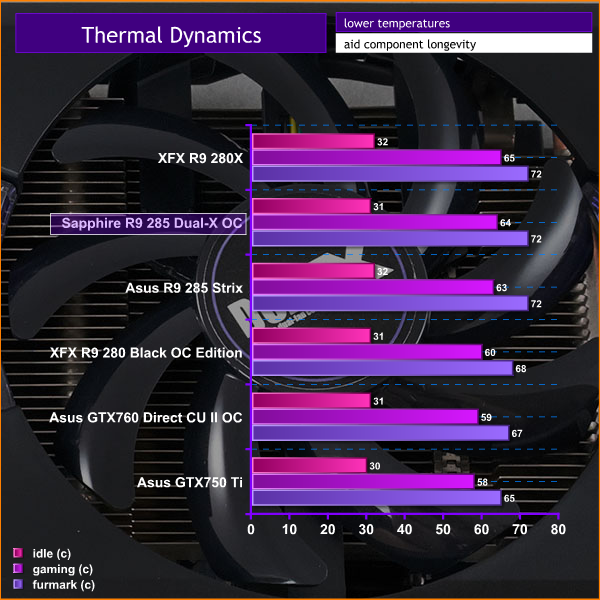The tests were performed in a controlled air conditioned room with temperatures maintained at a constant 24c – a comfortable environment for the majority of people reading this. Idle temperatures were measured after sitting at the desktop for 30 minutes. Load measurements were acquired by playing Crysis Warhead for 30 minutes and measuring the peak temperature. We also have included Furmark results, recording maximum temperatures throughout a 30 minute stress test. All fan settings were left on automatic.


The Dual-X cooler performs very well, just slightly outperformed by the cooler on the Asus STRIX (a single degree). Under normal gaming load, it held at 64c.
Tags AMD R9 285 AMD R9 285 review ATI R9 285 ATI R9 285 review Review Sapphire R9 285 Sapphire R9 285 Dual-X OC Sapphire R9 285 Dual-X OC Review Sapphire R9 285 review
Check Also
Assassin’s Creed Shadows surpasses 1 million players on day-one
After a ton of waiting and many delays, Assassin’s Creed Shadows is finally here. While Ubisoft’s latest AC title may not be able to singlehandedly dig the publisher out of the hole it’s found itself in, initial response to the game appears solid, with the title having surpassed 1 million players in just a couple hours.
 KitGuru KitGuru.net – Tech News | Hardware News | Hardware Reviews | IOS | Mobile | Gaming | Graphics Cards
KitGuru KitGuru.net – Tech News | Hardware News | Hardware Reviews | IOS | Mobile | Gaming | Graphics Cards



I agree with what was said on the pricing. Why buy this right now when you can get good deals on R9 280s?
It’s a replacement for the 280…so the price diff will only last as long as the 280s last.
Hmm, the KitGuru noise guide is a bit low on the decibels. And holy crap, I just realized how energy efficient the 750 ti is compared to its sadly low power :/ If only all cards wasted that few watts 🙁
This is a clear and concise review one of the best I’ve come across. Your use of similarly OC AIB customs leaves the reader not conjecturing like so many that went reference 760’s.
The 285 is a fine substitution for the 280, and while there’s still great deals on a lot of the 280’s, yes you’d have to quandary in which to go with. If your one to kind of think of a C-F in the near term, I’d say a 285 as it including CrossFire XDMA might make a strong contention (like to see C-F 280’s vs. 285’s). I think if I recognized I wasn’t predicting a monitor upgrade (1440p) during the life of the card, the choice of improved tessellation performance, along with it quad-shader layout, allowing four primitives to be rendered per clock cycle instead of two might be more useful as more titles evolve. Lower power is good, while I don’t see the whole memory @1080p add any apprehension.
It’s a hard call on the AMD side between (they win either way)… but consigns the 760 as no longer any smart deal. Then with Nvidia saying “nothing” as to its’ pricing, while bring it’s big brother into the fight with its price drop, one can pretty much figure Nvidia will let the 760 go quietly into the night.
Look at the 750Ti as the “5670” for the mainstream resolution today, just as the 5670 the no aux-power choice when 1680×1050 was in vogue. Given @1080p with the setting at medium is more its place to keep from “slide show” Fps, judging it in with this group is frivolous. Look at similarly OC customs of a 750Ti and 260X when gaming, the 260X needs 20% more while neither offer any difference in settings or immersion.
It’s nice to save power during 2-3 hours of gaming, but if you sleep (monitor off) AMD ZeroCore drops to 2-3W, while the 750Ti draws 5-7W when no one is using it perhaps 18 hours a day! If you really look at the total efficiency over a month’s power usage that saving is not all that pronounced.